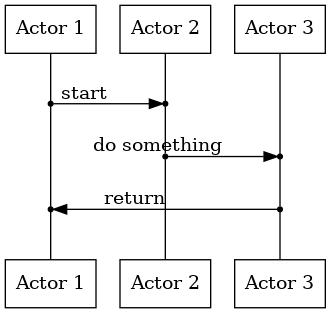digraph G {
{ // Define the actor nodes in the top
// Make sure they're on the same row
rank=same;
// Style the actor nodes
node [shape=box];
actor1_top [label="Actor 1"];
actor2_top [label="Actor 2"];
actor3_top [label="Actor 3"];
// Tie them together in the right order
edge [style = invis];
actor1_top -> actor2_top -> actor3_top;
}
// Define the actor nodes in the bottom. This is a copy paste
//of the top subgraph - s/top/bottom/g
{
rank=same;
node [shape=box];
actor1_bottom [label="Actor 1"];
actor2_bottom [label="Actor 2"];
actor3_bottom [label="Actor 3"];
edge [style = invis];
actor1_bottom -> actor2_bottom -> actor3_bottom;
}
// Style the event nodes
node [shape=point];
edge [arrowhead=none];
// Define the event nodes. Here they are prefixed with
// the actor name.
actor1_event1
actor1_event3
// Now we connect each of the events like pearls on a string.
actor1_top ->
actor1_event1 ->
actor1_event3 ->
actor1_bottom;
// Repeat. The event above has a corresponding node in the
// destination actor.
actor2_event1
actor2_event2
actor2_top ->
actor2_event1 ->
actor2_event2 ->
actor2_bottom;
// And one more time.
actor3_event2
actor3_event3
actor3_top ->
actor3_event2 ->
actor3_event3 ->
actor3_bottom;
// We connect each event src/dest. First we make sure they
// are vertically aligned.
{rank=same; actor1_event1 actor2_event1}
{rank=same; actor2_event2 actor3_event2}
{ranke=same; actor3_event3 actor1_event3}
// Finally, we connect the dots.
edge [constraint=false, arrowhead=normal];
actor1_event1 -> actor2_event1 [xlabel="start"];
actor2_event2 -> actor3_event2 [xlabel="do something"];
actor3_event3 -> actor1_event3 [xlabel="return"];
// We use xlabel, as normal labels will skew the whole thing.
}

